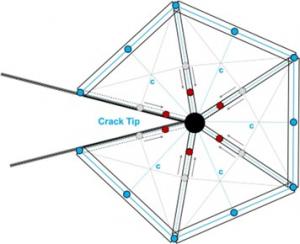Inverse Crack-Tip Element for Health Assessment of Pre-cracked Structures
GA, UNITED STATES, December 18, 2024 /EINPresswire.com/ -- A recent study introduced a novel in-plane inverse crack-tip element that aims to transform structural health monitoring (SHM) in structures with preexisting cracks. This innovative approach uses an inverse finite element method (iFEM) to provide accurate structural health assessment by monitoring mixed-mode stress intensity factors in real-time, enhancing safety, optimizing maintenance, and reducing costs.
Structural health monitoring (SHM) is vital for safeguarding infrastructure by identifying and addressing damage risks. Traditional methods, however, often struggle to deliver accurate real-time data on high-stress areas, like crack tips, where failure is most likely. These regions require careful monitoring to predict and prevent catastrophic structural failure. Yet, capturing the complexities of stress concentrations at crack tips remains a significant challenge. This study addresses these shortcomings by proposing a novel solution to achieve real-time structural assessments of pre-cracked structures.
Researchers from the National University of Sciences & Technology, Islamabad, and the University of Strathclyde, Glasgow, have introduced an innovative contribution to the field of SHM, published (DOI: 10.1002/msd2.12136) on November 29, 2024, in the International Journal of Mechanical System Dynamics. Their study introduces a two-dimensional, six-node triangular inverse crack-tip element formulated to ensure strain singularities at the crack tip without compromising computational efficiency, enabling real-time health assessments of cracked structures.
The study presents a two-dimensional, six-node triangular inverse crack-tip element, marking a significant advancement in SHM of through-thickness pre-cracked structures. The proposed crack-tip element integrates seamlessly with the inverse finite element method (iFEM) for shape-sensing and health assessment applications of engineering structures with and without preexisting cracks. A critical characteristic for accurate fracture analysis is maintaining strain singularities at the crack tip, accomplished by strategically repositioning mid-side nodes in this research. The element is adaptable to both structured and unstructured mesh discretization, making it highly versatile for modeling complex geometries, particularly in areas of high stress, such as crack tips. Rigorous validation confirms its effectiveness in shape-sensing and computing stress intensity factors (SIFs) across various crack geometries and loading conditions, highlighting its potential to revolutionize real-time monitoring of structures with preexisting cracks.
Prof. Dr. Erkan Oterkus, the corresponding author and supervisor of the research, is of the view that “the formulation of the inverse crack-tip element represents a step forward in structural health monitoring and the assessment of engineering structures with preexisting cracks. This approach enables precise shape-sensing capabilities and accurate reconstruction of critical fracture parameters, which are crucial for timely and informed decision-making regarding the maintenance and safety of critical infrastructure.”
This research has transformative potential across industries where structural integrity is paramount, notably in the aerospace and marine sectors. It enhances safety by detecting issues early, reduces maintenance costs through targeted repairs, and extends the lifespan of vital structures. Automating and streamlining the evaluation process minimizes downtime and operational disruptions, paving the way for more innovative, efficient, and sustainable infrastructure management.
DOI
10.1002/msd2.12136
Original Source URL
https://doi.org/10.1002/msd2.12136
Lucy Wang
BioDesign Research
email us here
Legal Disclaimer:
EIN Presswire provides this news content "as is" without warranty of any kind. We do not accept any responsibility or liability for the accuracy, content, images, videos, licenses, completeness, legality, or reliability of the information contained in this article. If you have any complaints or copyright issues related to this article, kindly contact the author above.

